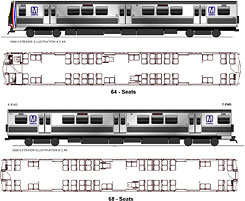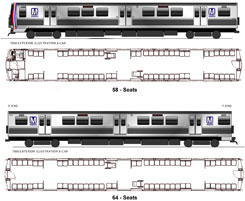7000 series designs sacrifice capacity for vague safety
The team working on the 7000 series, the next generation of Metrorail railcars, has chosen to keep the current “transverse” seating instead of switching to a “longitudinal” arrangement based on unquantifiable safety benefits. In doing so, they’ve given up the opportunity to substantially increase Metro’s capacity as overcrowding gets worse.
Early designs for the 7000 series had two possible seating arrangements under evaluation. The first, transverse seating, is what Metro uses today. The new cars make some specific changes to the current layout, including moving the end doors closer to the center and therefore having more seats at the ends and fewer in the middle. In general, though, it’s what we’re all used to.
The other option, longitudinal seating, involves a row of seats facing the center on each side. Many transit systems around the world use this seating arrangement. It has the advantage of holding more standees, as there is more open space in the center.
The longitudinal arrangement does sacrifice some seats, though surprisingly not very many. It seats 122 per pair of cars, compared to 126 per pair in the current (transverse) 6000 series, and 130 per pair on the 7000 series in transverse configuration. But it holds more people standing. If trains started using longitudinal seating, the seats would fill up scarcely faster than they do today, but trains wouldn’t become crush-loaded as much.
Similarly, Metro decided not to explore having 4 doors per side on each car. Many other systems have 4 doors on cars of this length. New York even has 4 doors on many 60-foot cars, compared to Metro’s 75-foot cars. More doors mean the car can load and unload faster, reducing dwell times and keeping trains moving. That increases capacity as well, because the faster each train gets in and out of the busiest stations, the sooner another train can come in and the more trains Metro can run overall.
Why has Metro chosen to forego this opportunity? They say it’s because of safety. According to Debo Ogunrinde in a presentation made to the Riders’ Advisory Council, the engineers believe there’s some safety benefit to transverse seating. Having seats in front of and behind some riders could keep them from sliding into other riders or flying toward the end of the railcar in the event of a crash.
The argument is similar for doors. Fewer doors mean stronger car walls. Of course, the wall strength wasn’t the problem in the June 2009 Red Line crash, where the cars telescoped, but there could be crashes where it matters.
That’s probably right. But is it worth sacrificing capacity? Consider that overcrowded platforms and escalators present their own safety hazards. And overcrowding is a certainty, while train crashes are hopefully avoidable.
And the more crowded Metro gets, the more people will drive. If they do, they’re much less safe. After the crash, BeyondDC calculated that driving Metro is 34 times safer per passenger mile than driving. Is the benefit of transverse seating 34 times greater than longitudinal?
Unfortunately, Metro’s engineers don’t have (or haven’t been willing to share) any sort of quantifiable assessment of the safety value of transverse seating. It’s just “some.” But we can’t tell if it’s more of a safety benefit than the safety benefit of less crowded platforms and escalators. And we don’t know if it’s more of a safety benefit than the benefit of moving a few more people by rail instead of by car.
Mr. Ogunrinde said that Metro felt if there were anything it could do, no matter what, to improve safety, then they would be remiss in skipping it. But is that really true? Why haven’t they designed the cars with seatbelts? What about four-point harnesses like on military jets? Airbags? Padded walls? If fewer doors is stronger, why are there still windows on the cars? Why don’t the cars have foam peanuts filling their space, which riders can worm their way through? Maybe Metro should run every train at 10 mph?
When the FTA first announced its desire to regulate trainsit safety, I worried that this shortsighted tradeoff is exactly what would happen. Regulators whose sole responsibility is to prevent deaths or injuries in crashes would push transit systems to make changes that reduce the risk of crashes but increase other risks, like crowding and driving. That’s what happened when the Federal Railroad Administraton over-regulated commuter and intercity railroads to make cars heavier and therefore slower, harming the overall value of rail passenger service.
FTA Administrator Peter Rogoff has assured everyone this is not what the FTA would do. He said,
We must remember that, despite WMATA’s safety challenges, every Washington area commuter is safer traveling on WMATA than they are traveling on our highways. Thus, we cannot allow any degradation in WMATA’s reliability and performance such that commuters opt to abandon Metro in favor of our already congested highways. We must also caution against any proposals that will reduce significantly WMATA’s existing capacity, forcing more commuters onto our highways. Any actions or proposals pushing WMATA riders onto our highways simply will degrade safety and worsen congestion in the region.
Hopefully he’s right and the FTA will avoid following the FRA’s path. But Metro is going ahead and doing the same thing all by themselves. I can understand the viewpoint of the railcar designers as well. If someone is hurt in a crash, people might ask why the railcars weren’t designed differently. But if people are hurt in stations, the questions won’t revolve around the railcars. And if people die out on the roads, nobody (except maybe us) asks why that person couldn’t have been on transit, where they would have been safer.
I don’t know if the current political climate allows Metro to design its railcars for the maximum capacity and with the overall transportation safety picture in mind instead of the narrow goal of safest railcars at any operational cost.
Certainly Congress keeps hammering at safety without really analyzing the big picture. Yesterday, a Senate committee approved this year’s $150 million federal contribution, but Senator Barbara Mikulski attached conditions that all money be spent on safety and WMATA report quarterly on its progress on safety. The focus on safety is important, but the big picture is more complex than a sound bite.
The Board is supposed to take the broader view. Can they? Is it politically feasible to approve railcars with higher capacity, which will cut down on unsafe overcrowding and reduce reliance on dangerous cars even though some engineers say that transverse seating is safer to some, undetermined and vague degree?
Hopefully they will, asking staff to go back to the longitudinal seating as well as evaluating whether it would bring additional cost to build railcars with 4 doors. Riders in 2030 would be glad they did.
Update: What about articulated cars, where the doors between some cars are replaced with flexible sections creating, in effect, double-length cars or even making the whole train a car? Mr. Ogunrinde said they had rejected that for three reasons.
First, security agencies say it would make things more difficult, perhaps by letting a suspect roam through the train to evade capture. That seems a little dubious. Second, there aren’t examples in the US of these working in heavy rail environments. However, there are plenty of examples around the world. But third, and the one that is somewhat persuasive to me, Metro’s existing facilities aren’t set up to be able to handle articulated cars, making it very costly to switch.


